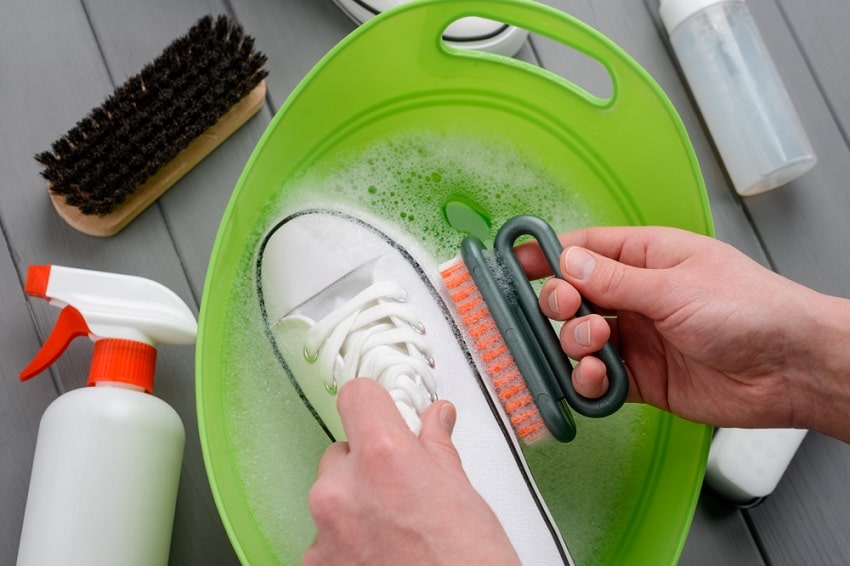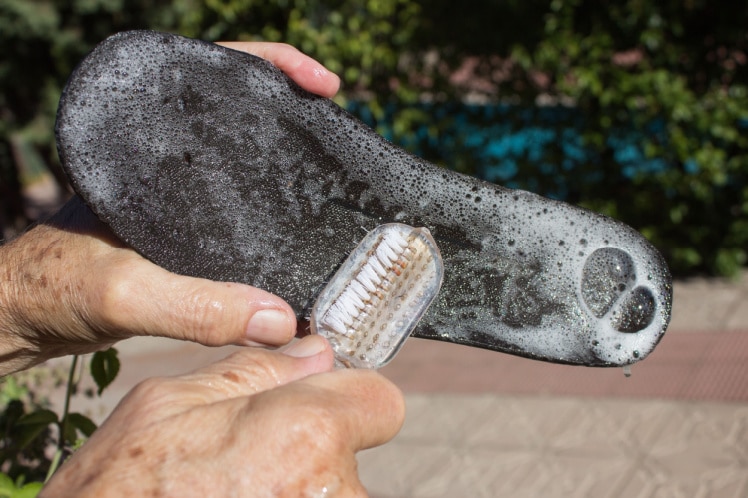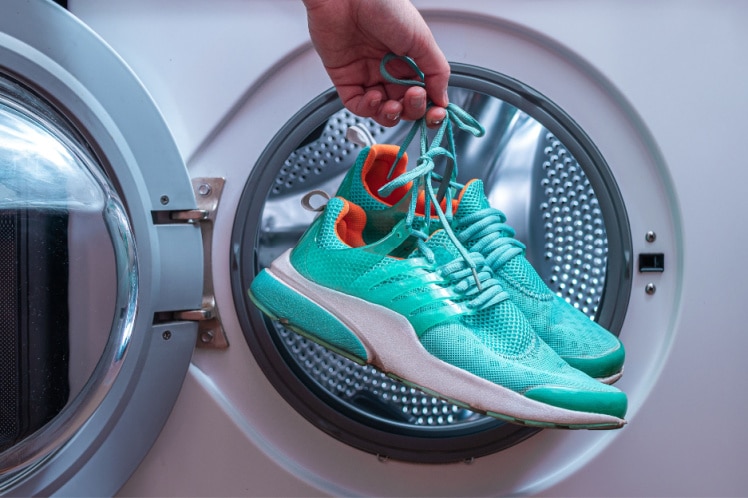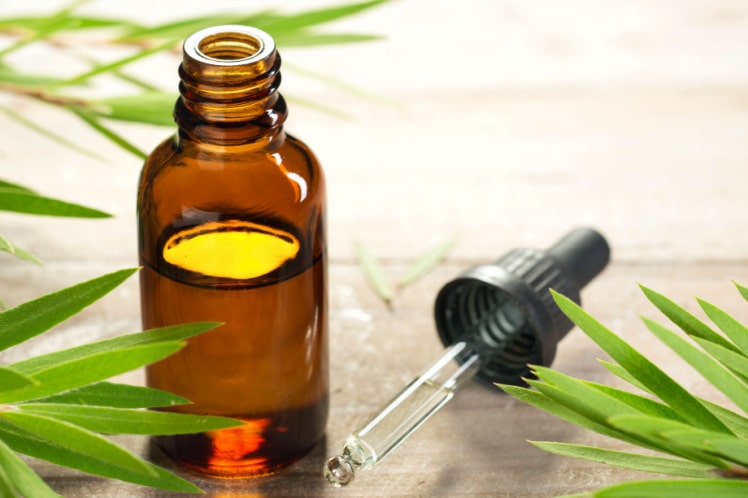
Buying used shoes does more than save you money. It allows you to rock vintage footwear that you can’t find on racks of new shoes. Plus, when the shoes have already been broken in, they’re less likely to give you blisters or rub your skin away.
One of the downsides of buying used shoes is that they might have dirt, grime, or scuff marks on them. Even if they’re in pristine condition, you might want to disinfect them before you wear them. You don’t know where they’ve been before.
Here are some tips for cleaning the interior and exterior of used shoes so that they look and feel as though they’ve always been yours.
Contents
Why Should You Buy Used Shoes?
Some people are wary about purchasing footwear that has been on other people’s feet. But wearing used shoes is not a health hazard. In fact, shopping for pre-owned shoes has several benefits.
You’ll save money. Used shoes are usually cheaper than new ones. Many are in great shape. Think of those shoes that you bought to go with a specific outfit but never really wore. If you donated those or sold them on consignment, someone else was probably thrilled to find them in an almost-new condition.
You can often find designer shoes at a fraction of the original price when they’re used. Buying pre-owned footwear is also a great way to snag rare, vintage pieces.
Purchasing second-hand shoes is good for the environment. It’s an excellent way to recycle, reducing carbon emissions, and keeping garbage out of landfills.
How to Disinfect Used Shoes
Germs are everywhere, including in your shoes. You can even find bacteria in new shoes. Therefore, you shouldn’t be afraid to buy pre-owned shoes. But you might want to disinfect them before you wear them.
On average, the soles of a pair of shoes are coated with 421,000 bacteria. Almost all of those germs end up on your floors when you walk on them. But bacteria aren’t only found on the outside of your shoes.
Your socks contain plenty of pathogenic material. Whoever wore your shoes before you bought them loaded them up with some germs. Therefore, you might want to clean the inside and the outside of your new-to-you footwear before you put it on.
This video shows you some tips for sanitizing sneakers.
1. Clean Used Shoes With Rubbing Alcohol
Did you know that you can soak used sneakers in rubbing alcohol? The chemical will kill off most of the bacteria, which can also help reduce odors.
Use this method by following the steps below:
- Dump rubbing alcohol into a large bowl or tub that can accommodate the shoes.
- Remove the insoles.
- Place the shoes in the bowl or tub.
- Put the insoles in the alcohol separately.
- Soak for one hour.
- Remove the shoes from the alcohol and let them dry.
If the shoes are delicate, you can wipe the inside and the outside with rubbing alcohol. You might also try sprinkling some on the insoles. Alcohol evaporates quickly, which means that it should dry faster than water.
2. Clean Used Shoes With Bleach
Bleach is a powerful disinfectant. You can use it on your shoes with care. Never put bleach directly on shoes. Always mix it with water first. You might not want to use bleach on the outside of your shoes unless they’re white. The bleach may discolor bright hues and leather.
You can spray it inside, though. Mix a small amount of bleach with plenty of water, and put it in a spray bottle. Mist the insides of your shoes and let them dry. The bleach kills viruses, fungi, and bacteria.
3. Use Antifungal or Antibacterial Spray
Athlete’s foot is a condition that’s caused by a fungus. It grows plentifully in warm, moist environments, such as sweaty shoes.
If you don’t know the medical history of the shoes’ previous owner, you might want to cover your bases by misting them with an antifungal product, such as a spray that you would use for athlete’s foot. Use it in the interior areas of the shoes. If the footwear is made of a porous material, such as canvas, feel free to spray an antifungal product on the outside of them too.
You can also use a household antibacterial spray, such as Clorox or Lysol, in your shoes. These products kill many types of bacteria. Mist an antibacterial spray inside of your shoes, and let it dry before you wear them.
4. Steaming
Some people use hand-held steam cleaners to sanitize the inside of used shoes. The high temperatures will kill off pathogens. You should be careful steaming suede shoes. However, you can use this method on most leather and cloth footwear.
How to Clean Used Shoes
Sanitizing the shoes isn’t always enough. While the tactics above can kill bacteria and viruses, they don’t thoroughly clean the shoes. Try the methods below for a deep cleansing that removes stains and dirt.
1. Clean the Insoles
The first thing that you can do when you bring home your thrifted shoes is to clean the insoles. Try to remove the piece that goes underneath your foot inside the shoe. If it’s removable, you can wash it in a bowl of warm, soapy water.

Mix a few cups of hot water with several drops of laundry detergent. Swirl it around until the detergent dissolves.
Place your insoles in the bowl and scrub them with a clean washcloth. Squeeze the water through them a few times. Just be careful not to damage the material. Some older insoles may be more likely to fall apart if you scrub them aggressively.
Rinse them under cold running water. Then, put them on a towel to dry. You could place them near a fan or a window to make sure that they don’t stay moist. Dampness can harbor bacteria.
Insoles tend to compress in a way that molds them to the previous user’s feet. Even if they’re perfectly clean, the insoles might make the shoes less comfortable for you. Therefore, many consumers prefer to replace insoles when they buy used shoes. Doing this will also take care of any cleanliness issues related to the insoles.
You might also like:
- Say Goodbye to Sticky Shoes: How To Get Gum Off Shoes
- How to Dry Shoes in the Dryer
- How to Blouse Your Boots
- How to Remove Creases from Shoes
- How to Make Big Shoes Fit
2. Toss Them in the Washer
Most cloth shoes, such as sneakers, canvas footwear, fabric flats, and running shoes, can be put in an electric washing machine. If you know that your shoes are machine washable, spin them on the warm cycle with concentrated laundry detergent.

You might not want to put them in the dryer, though. The heat could lock in any unwanted smells. It may also shrink the shoes, melt the glue, and warp the soles.
Air-dry the shoes in a well-ventilated area. You might want to stuff them with white washcloths to remove additional moisture. Change out the washcloths a few times a day.
Most leather shoes should not go in the washing machine. However, you can wash running shoes that are made out of a combination of cloth and leather. When in doubt, look up washing instructions on the manufacturer’s website.
If you have a top-loading washing machine, you might want to throw some towels in to balance out the weight of the sneakers. You don’t typically have to do this with a high-efficiency washer, though.
Before putting shoes in the washer, vacuum them using the hose attachment. When you do this, you’ll remove any dirt, stones, and debris that can end up damaging the shoes or the washer. You’ll also prevent grime from getting caked into the shoes.
Some other tips for cleaning used shoes in the washing machine include:
- Remove the laces
- Take out the insoles and wash them separately
- Use heavy-duty detergent
- Wash them on the warm cycle
- Put the shoes in a mesh laundry bag
- Use a low spin speed to prevent the washer from getting unbalanced
3. Hand Wash Delicate Shoes
If you’re worried about putting nice shoes in the washing machine, you have another option. Try cleaning them by hand.
Combine liquid laundry detergent with warm water. Then, scrub the inside and outside of the shoes using a soft brush or cloth. Wipe the shoes down with a rag soaked in clean water to remove the soap.
You might wonder whether you can hand wash leather shoes. The answer is yes. Use a rag and a light touch. Minimize the amount of water that you use.
If you’re cleaning suede shoes, use extra care. This type of footwear doesn’t respond well to lots of moisture. Still, you can use a damp rag to buff out scuff marks and stains. Wash the shoes using downward strokes. Take suede shoes to a professional cleaner if you’re not sure whether they’ll hold up to hand-washing.
4. Remove Scuffs
Are you worried that scuffs or marks on your shoes make them look old? If the cleaning methods above didn’t remove the stains, you can try a few spot-treatment techniques.
Remove scuffs from leather or imitation leather using a paste made from baking soda and a small amount of water. Use a damp cloth to rub the paste on the shoe using circular motions. Be gentle so that you don’t scuff the shoe.
Dark shoes can develop light-colored scuffs that stand out. If you don’t have shoe polish, try camouflaging these areas with a permanent marker in a color that matches the leather. Buffing patent leather shoes with petroleum jelly gets rid of scuffs. Glass cleaner also works on shiny, faux-leather shoes.
Some leather shoes develop salt stains when you wear them outdoors in the winter. You can remove this white residue using a wet washcloth that has been dipped in white vinegar.
Do you have scuffs on used suede shoes? You’ll have to be extra careful with this delicate material. Try using a pencil eraser to rub out dry stains. Sprinkle cornstarch on oily stains to draw them out. Let the powder sit on the shoe for a minimum of one hour. Then, brush it away using a soft toothbrush.
Another type of shoe that’s difficult to clean is the kind with a rope or cork-covered sole, such as an espadrille. If the edges of the soles are dirty, clean them with a mixture of 4 cups warm water, ¼ cup white vinegar, and 1 teaspoon dishwashing detergent.
Scrub the dirty areas gently with a toothbrush dipped in the cleaning solution. Work in one direction to prevent the soles from fraying if they’re made of rope.
Read Also: How to Clean White Shoelaces
How to Clean Smells Out of Used Shoes
Do your used shoes smell bad? You might be tempted to mask the odors. However, if you don’t kill the bacteria, the stink will come back. Therefore, only try the following methods after you’ve cleaned and deodorized the shoes.
1. Baking Soda
Baking soda can be stinky shoes’ best friend. Sprinkle it inside the shoes, and place them in a plastic bag overnight. In the morning, dust off the baking soda. You might need to sprinkle baking soda in the entire shoe instead of just the insole. Use the method above, but shake the baking soda into the shoe—insole and all—before putting it in the plastic bag.
2. Vinegar
You can also try washing the insoles with a solution of water and vinegar. Mix equal parts white vinegar and warm water. Submerge the insoles, and work the mixture into them as much as possible. Rinse them under clear tap water.
Once the insoles have dried, they won’t smell like vinegar anymore. Plus, the solution should kill off much of the bacteria that cause shoes to stink.
3. Alcohol
If baking soda and vinegar don’t de-stink your shoes, you can try the alcohol method that we described above in the section about disinfecting used footwear. Soaking shoes in alcohol allows the chemical to seep into the deepest pores of the shoes. This strategy can get rid of strong odors that have lingered for years.
4. Dryer Sheets
Dryer sheets can infuse your shoes with a pleasant odor and make them smell fresh. To use this method, put two dryer sheets inside of each shoe. Let them sit for a few days. You can even put them in a plastic bag for better stink-eliminating action.
Remove the dryer sheets before you wear the shoes. If the footwear is particularly smelly, you can try removing the insole, folding a dryer sheet to fit the bottom of the shoe, and placing the dryer sheet under the insole. Don’t remove the dryer sheet before wearing the shoes.
Keeping the dryer sheet under the insole can also prevent your shoes from squeaking. You will probably need to change it out every few weeks.
5. Freezer
Have you ever heard that you can put smelly shoes in the freezer? This method inactivates bacteria. However, it doesn’t kill it. Therefore, your shoes may smell fresh when you pull them out of the cold environment, but they might start to stink again as soon as you put them on. Plus, you probably don’t want to put dirty shoes that someone else has worn near your frozen food.
6. Cat Litter or Charcoal
Cat litter has odor-absorbing properties. Although it might seem strange to put it in your shoes, it can deodorize them. Pour some kitty litter into a pair of old socks. Seal them with a rubber band or twist tie. Keep the litter-filled sock inside of each shoe when you’re not wearing it.
Charcoal works like cat litter to absorb odors. You can fill old socks with charcoal and store them in your shoes to keep odors at bay.
7. Tea Tree Oil

Tea tree, or melaleuca, is an essential oil with antibacterial and antifungal properties. Mix several drops with some water. Then, spray it inside of the shoe and let it dry. Do this as often as necessary to kill the stink.
Read Also: Best Shoe Deodorizer and Best Shoe Cleaners
Keep Your Shoes Protected
After you’ve cleaned your shoes, you likely want to keep them looking sharp. Polish leather shoes with an appropriate product to restore their shine and remove scuffs. Use a leather conditioner to soften the material and prevent it from cracking.
If you bought fabric shoes, protect them with a fabric spray that’s designed for footwear or upholstery. It will prevent stains from being absorbed into the porous material. Fabric spray also repels dirt.
Latest Post:
- Where Are Vans Made? (Ultimate Guide Revealed)
- How Much Do Shoes Weigh?
- Lights On, Troubles Gone: How to Fix LED Shoes Like A Pro
- Do Vans Run Big or Small? (All You Need To Know)
- Do Adidas Run Big, Small or True to Size?
How to Buy the Best Used Shoes
When you’re shopping for used shoes, you can avoid spending a lot of time cleaning them by making good purchasing decisions. Inspect the shoes well before you pay for them. Here are some tips on what to look for in a pair of used shoes:
- Is the tread intact, or is the bottom of the sole smooth?
- Are there any holes or extremely eroded spots in the sole?
- How does the shoe smell?
- Are both shoes the same size? (Hint: try them both on.)
- Are the shoes manufactured by a reputable, high-quality brand?
Look for signs of breakdown before you buy the shoes. Uneven wear on the soles can create pressure points on the bottom of your foot. Check for cracks in the soles and the uppers. Moisture can seep through openings in the base of the shoes. Cracks or creases in the leather can press on or rub your skin.
Choosing high-quality shoes that are in great condition and fit you well is one of the keys to buying used shoes. Once you’ve cleaned them, they may feel as though they’ve always been yours.
